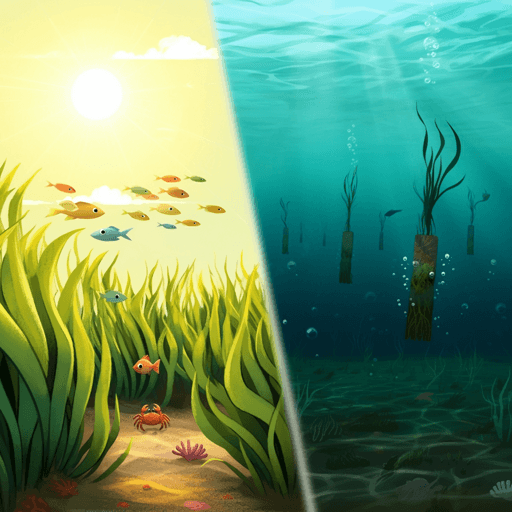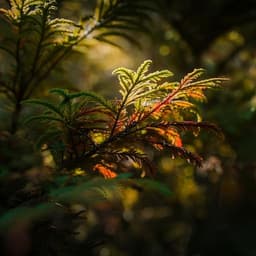
Environmental Studies and Forestry
Evaluating Habitat Provisioning and Restoration Potential of a Subtropical Seagrass Species in a Temperate Estuary
S. N. Trackenberg, C. J. Baillie, et al.
Seagrass restoration in North Carolina may need a tropical twist: surveys and a transplantation experiment show Halodule wrightii expands from April to September, varies morphologically with depth, and survives small intertidal transplants >18 months while nearly all subtidal transplants disappear within six months. Restored plots hosted fewer and less diverse fauna than natural beds, suggesting small-scale transplantation alone may not recreate functional habitat. Research was conducted by Authors present in <Authors> tag.
~3 min • Beginner • English
Introduction
Coastal biogenic habitats like seagrass meadows provide essential ecosystem services, including shoreline protection, nutrient cycling, carbon sequestration, and nursery habitat for diverse nekton. Despite their importance, global seagrass extent has declined markedly, prompting increased but variably successful restoration efforts. In North Carolina’s transition zone between temperate and subtropical ecosystems, meadows comprise Halodule wrightii, Ruppia maritima, and Zostera marina. Climate warming and changing water clarity are shifting species composition toward H. wrightii, which has higher thermal tolerance and rapid recovery capacity. The study aimed to address two core questions: (1) how abiotic (depth) and temporal (seasonality) factors influence the distribution and morphology of H. wrightii; and (2) how depth (intertidal vs. subtidal) impacts restoration success of H. wrightii and its associated motile fauna. Hypotheses included: at shallow depths H. wrightii co-occurs more with R. maritima and shows greater leaf numbers and widths, while at deeper depths H. wrightii co-occurs more with Z. marina and exhibits longer shoots; H. wrightii would be seasonally dominant in mid- to late-summer; restoration potential (survival/persistence) would be equivalent across intertidal and subtidal depths; and faunal use of restored H. wrightii would increase with depth and seagrass cover.
Literature Review
Prior work identifies depth as a key driver of seagrass light environment, morphology, and survival, with trade-offs between desiccation stress in shallow waters and light limitation at depth. Restoration success is sensitive to site selection (energy regime, depth), methods (seed vs. transplantation), donor population, and scale, with larger-scale efforts and facilitation often improving outcomes. In NC, Z. marina restoration has been more studied than H. wrightii, though recent warming trends suggest H. wrightii may become dominant. Studies also show seasonal species turnover, depth-linked community differences, and the potential existence of “goldilocks” zones for restoration within species’ natural depth ranges. Genetic diversity and positive biotic interactions (e.g., with bivalves) can enhance restoration success and ecosystem functioning.
Methodology
Study area: Back Sound, Carteret County, NC, a shallow, high-salinity, well-mixed estuary with semidiurnal tides. Surveys: Two years of field surveys assessed seasonality (April–September 2019) and depth gradients (June–July 2020). In 2019, six beds per month were randomly selected from 20 meadows. At each bed, three 50-m transects were established; percent cover of Z. marina and combined H. wrightii/R. maritima and canopy height were measured in 0.0625-m² quadrats every 5 m. A single 10-cm diameter, 15-cm deep core per transect was taken at the first location exceeding 50% cover (or highest cover) to quantify shoot density and morphology. For each species within cores, five shoots were haphazardly selected to measure shoot length, leaf width, leaves per shoot, branch number (R. maritima and reproductive Z. marina), and aboveground biomass; remaining shoots were identified, counted, separated into above/belowground biomass, dried (60 °C), and weighed. In 2020, 18 beds were sampled (June–July) using five haphazard quadrats per bed for cover and canopy height; bed elevation (proxy for inundation depth) was measured at each quadrat using RTK GPS (Trimble R10), expressed relative to NAVD88; seagrass cores were processed identically. Epibiont load: In 2020, epibionts were scraped from five shoots per species per core; blade dimensions recorded; blades and scraped epibionts dried and weighed; epibiont load standardized by blade weight. Transplant experiment: 27 plots (2×2 m) with treatments: intertidal transplanted (N=5), subtidal transplanted (N=6), intertidal sand flat (N=6), subtidal sand flat (N=5), and continuous intertidal seagrass control (H. wrightii-dominated; N=5). Elevation categories: intertidal (−0.4 to −0.55 m NAVD88; ~0.3–0.45 m below LMSL) and subtidal (−0.6 to −0.8 m NAVD88; ~0.5–0.6 m below LMSL). Transplant method: April 26–28, 2021, 23 clumps per plot (15 shoots/clump) of H. wrightii from a nearby bed (<400 m), outplanted using the staple method, ensuring intact roots/rhizomes; lawn staples used for anchoring. High winds and stingray disturbance necessitated supplemental planting on May 25, 2021 to restore 23 clumps/plot. Initial clump biomass was measured on samples from April (mean 0.605±0.058 g DW) and May (0.639±0.1 g DW); initial shoot lengths from 10 clumps (intertidal vs. subtidal assignments) were recorded. Monitoring: Every two weeks June–October 2021 and 2022, counted remaining clumps per plot. Faunal monitoring: Deployed baited minnow traps (standardized to 24 h CPUE) biweekly in all 27 plots; identified, enumerated, and weighed fishes and macroinvertebrates. Squid pops: single pop per plot, 24-h deployment, checked at 1, 2, and 24 h for consumption status; proportion consumed averaged per plot across dates. SMURFs: 2-week deployments monthly to sample larval/juvenile fishes and crustaceans between plots in subtidal and intertidal sand flats and within intertidal continuous seagrass; organisms identified to species and measured. Statistics: LMMs/GLMMs assessed effects of month (2019), site (random), and species dominance on composition/morphology; binomial GLMs for percent cover (scored 0: 0–50%, 1: 50–100%). 2020 LMs/GLMs tested effects of bed depth (relative to LMSL) on composition/morphology; canopy height modeled against H. wrightii/R. maritima vs. Z. marina dominance. Transplant analyses: ANOVAs for depth differences among plot types; LMM for clump persistence over time by depth (2021) and intertidal only (2022); ANOVA with Tukey post hoc for minnow trap CPUE across plot types; quasi-Poisson GLM for CPUE vs. clump number and depth. Community analyses: PERMANOVA, PERMDISP, SIMPER on log(x+1) transformed catches using Bray-Curtis similarity; NMDS visualization; comparisons constrained by available intertidal continuous seagrass. Squid pop consumption: quasibinomial GLMs testing effects of transplantation category and depth, and habitat type; Tukey post hoc for pairwise differences.
Key Findings
- Seasonal dominance and composition: H. wrightii dominance increased from April to September; beds showed 1–3 species with highest three-species diversity in June (67%) and July (50%). H. wrightii + R. maritima percent cover increased from April through September (p=0.0020), with higher cover in June–July vs. April–May (p=0.0045). Z. marina percent cover was consistently low (<50%) and peaked in biomass and shoot counts in May.
- Morphology over time: All species exhibited temporal structural changes. Z. marina had narrower leaves and fewer leaves per shoot in July–August vs. April–June, with peak reproductive branching in April. R. maritima had longest shoots in June and fewer branches in August; leaves per shoot did not vary across months. H. wrightii shoots lengthened from April to July, then shortened in August–September; leaves per shoot generally increased monthly, peaking in June.
- Depth effects: Across June–July 2020, seagrass presence/productivity (cover, dominance, biomass) did not differ significantly with bed depth. However, deeper beds had fewer and longer H. wrightii shoots (p<0.05) and marginally taller canopy height (p=0.0529). Epibiont load did not vary with depth.
- Bed depth range: Shallowest bed averaged 0.41±0.01 m below LMSL; deepest averaged 0.84±0.06 m; overall range 0.32–1.01 m below LMSL.
- Transplant survival: Intertidal plots averaged 0.40±0.01 m below LMSL; subtidal 0.58±0.02 m (p<0.001). Initial shoot lengths did not differ between depth categories (intertidal 81±3 mm vs. subtidal 76±3 mm; p=0.2745). Clumps declined from 23/plot (May 25, 2021) to 8.4±2.8 (intertidal) and 1.3±0.8 (subtidal) by Oct 5, 2021; intertidal plots lost clumps significantly slower than subtidal (p=0.0009). By April 2022, subtidal plots had 0 clumps; intertidal clumps declined from 8.4±2.8 (Jun 8, 2022) to 0.8±0.8 (Oct 4, 2022; p<0.001), with none remaining by April 2023.
- Faunal communities: Minnow trap CPUE was highest in intertidal continuous seagrass (18.1±0.8 organisms; p<0.0001) compared to all other plot types. CPUE decreased with fewer transplanted clumps (p=0.0029), but did not differ between intertidal vs. subtidal transplanted plots (p=0.874) and showed no interaction with clump number by depth (p=0.087). Community composition differed by date and plot type, with continuous seagrass distinct from intertidal transplanted and sand flats; within-group dispersion was more variable for transplanted and sand flats than continuous seagrass. SMURF-based comparisons reflected similar patterns constrained to intertidal continuous seagrass and sand flats.
- Predation proxy: Squid pops were fully consumed at 24 h across all plots. At shorter intervals, consumption differed among treatments, with lower early consumption in intertidal transplanted plots relative to intertidal sand flats, suggesting possible refuge effects and limited consumer access at low tide.
Discussion
Findings indicate that H. wrightii is seasonally dominant across shallow NC estuarine meadows and that its morphology varies over time more than with depth within the sampled range. Restoration outcomes revealed a potential “goldilocks” depth for transplantation: intertidal transplants persisted longer (>18 months) than subtidal ones (<6 months), despite H. wrightii’s natural presence across both depth ranges. This suggests that restoration success is not simply a function of the species’ natural distribution, but is constrained by environmental stressors and establishment thresholds. Small-scale, low-density transplantation did not recreate the faunal community structure or abundance found in natural continuous beds, highlighting that persistence of plants does not equate to restored habitat function. Limitations such as transplant density, potential disturbance (e.g., stingray scouring), and likely low genetic diversity may have contributed to low survival and reduced habitat provisioning. The results underscore the importance of proper siting, adequate scale of planting, facilitative interactions (intra- and interspecific), and genetic considerations in restoration design. Anticipated climate change and sea level rise may shift suitable depth ranges and threshold positions, further necessitating adaptive restoration strategies informed by ongoing monitoring and experimentation.
Conclusion
The study documents seasonal dominance of H. wrightii and limited depth-related differences in seagrass presence and morphology within shallow Back Sound, NC. Transplant experiments show intertidal H. wrightii outplants persist longer than subtidal outplants, but small-scale transplantation failed to maintain long-term survival or restore faunal communities to levels of natural continuous beds. To improve restoration success and habitat provisioning, future efforts should: (1) optimize siting within favorable depth ranges and consider shifting thresholds under sea level rise; (2) increase transplant density and spatial scale to leverage sediment stabilization and reduced scouring; (3) incorporate facilitation (e.g., mixed-species plantings, bivalve additions) and enhance genetic diversity of donor material; (4) conduct broader surveys across deeper ranges and seasons to refine species dominance patterns; and (5) explicitly target ecosystem functioning (faunal habitat, nursery services) alongside plant persistence in restoration objectives.
Limitations
- Depth range sampled for surveys was relatively shallow (<1 m below LMSL), potentially underrepresenting deeper Z. marina-dominated beds during peak seasons.
- Transplantation was small-scale and low-density, which may limit survival, growth, and habitat provisioning compared to larger-scale plantings.
- Early transplant losses due to high winds and observed stingray activity suggest disturbance impacts that could confound treatment effects.
- SMURFs could not be deployed within transplanted plots, limiting direct comparisons of early-stage recruitment in restored areas.
- Likely low genetic diversity due to clonal reproduction of H. wrightii in NC may have reduced transplant resilience.
- Continuous seagrass controls were only available at intertidal depths, constraining community comparisons across depths.
Related Publications
Explore these studies to deepen your understanding of the subject.







